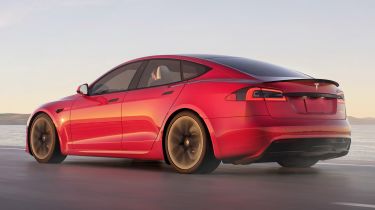Tesla Model S hatchback - Range, charging & running costs
The Tesla Model S is very expensive to buy, but should be inexpensive to run
Let's address the elephant in the room first: the Tesla Model S is an expensive car to buy whichever version you choose. However, while rivals such as the Porsche Taycan boast a lower starting price, you need to pay extra to even come close to matching the Model S’ level of range and performance.
Tesla Model S range & charging
In late 2020 the Tesla Model S received a range of updates to make it even more efficient. The changes made the car slightly lighter and also included a tweaked regenerative braking system, giving the most efficient model an official range of 405 miles from the same 100kWh battery pack as before. Choose the high-performance Plaid model and this drops very slightly to 390 miles.
Not only can it travel around 10% further than before, but the latest Model S is also compatible with Tesla's newest Superchargers, which are capable of 250kW charging; that means around 200 miles of range can be added in around 15 minutes – the time it takes for an average break at motorway services. The Supercharger network is constantly expanding, too, so most drivers will find one relatively close to home. New buyers no longer get free access to the Supercharger network, though, as this offer was withdrawn a few years ago.
More reviews
In-depth reviews
While frequently using a public charger can get expensive, topping up your Model S at home means it can be cheaper to run on a pence-per-mile basis than any petrol or diesel-engined rival. All electric cars are exempt from paying VED (road tax) until 2025, while their rock-bottom CO2 emissions attract the lowest Benefit-in-Kind (BiK) rate for company-car drivers. Like all other EVs, the Model S is also exempt from the London Congestion Charge and other low or zero-emission zone fees.
Insurance
All versions of the Tesla Model S are rated in the highest group 50 for insurance, which means they won’t be cheap to cover. However, given the car’s performance is comparable and sometimes better than models like the BMW M5, Audi RS6 and Mercedes E63, this shouldn’t come as a big surprise.
Servicing
Tesla offers a clever servicing package, so you know precisely what you’re in for when purchasing a Model S. The four-year scheme covers consumables such as wiper blades and brake pads, but not tyres. This makes the car's running costs very transparent and manageable – and they should be a lot lower than for an average family car.
Warranty
Tesla provides an eight-year/unlimited-mileage warranty for the Model S battery and electric motors, which is fully transferable to a new owner. The rest of the car is covered by a four-year/50,000-mile warranty.









